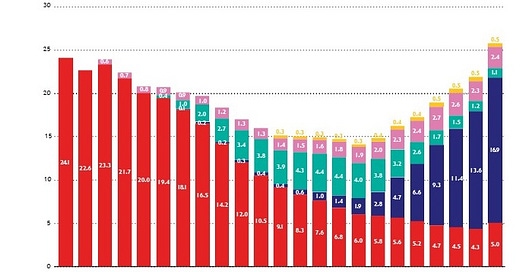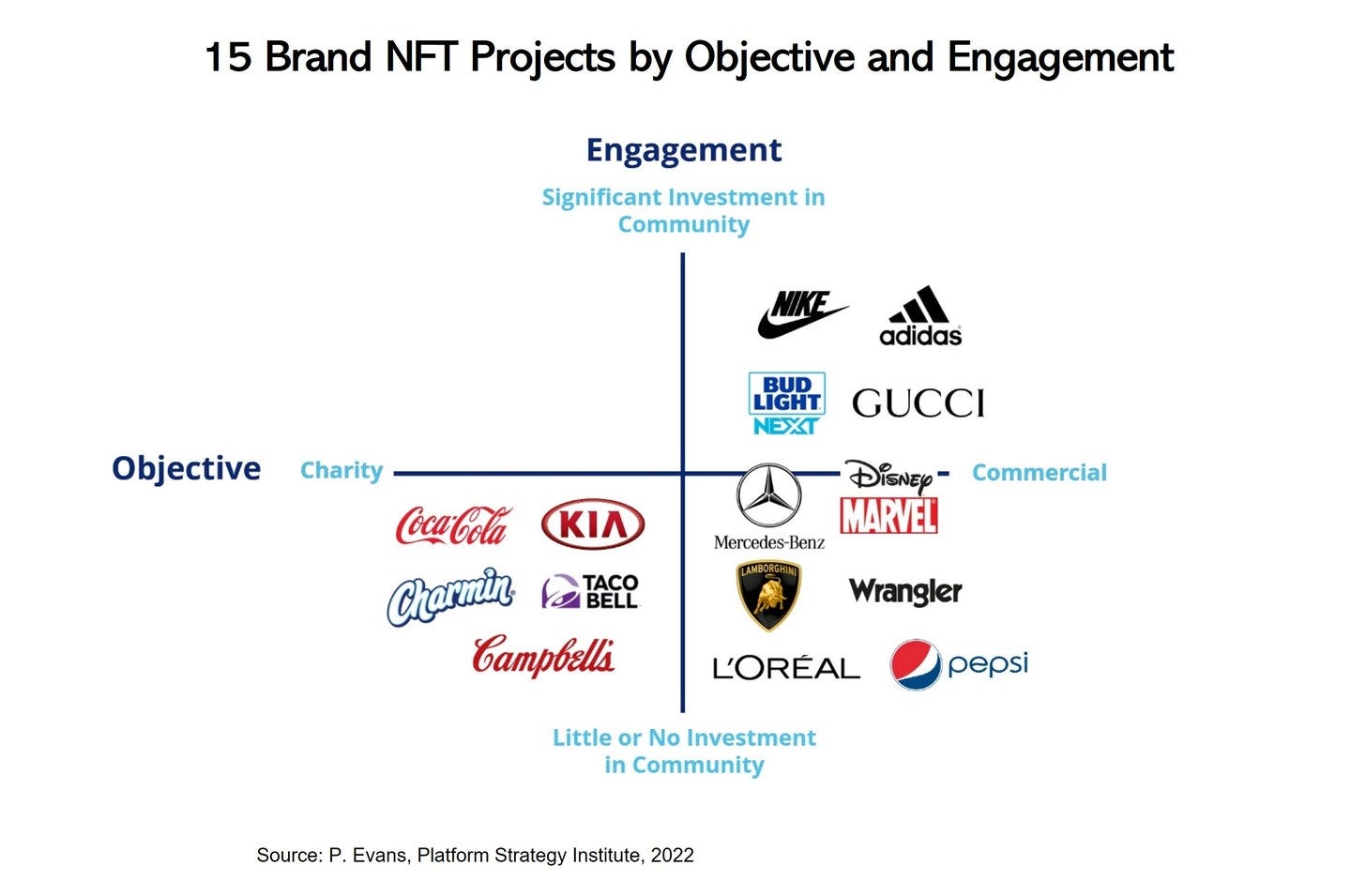✖️ What's the value of unbundled music?
And: 153 tools to promote music; Web3 adoption through DSPs, but wealth-sharing through communities; Spotify trials Google third-party billing; Sync in Web3; NFT Brand design & platform strategy
Why is one music NFT worth 1ETH while another is worth USDC5? This is a question of valuation, but also a question about the intrinsic value of music. With piracy, music seemed to lose all its value, but it’s now clear that people are happy to pay. It’s just that we, as listeners, have gotten used to having all the music we want at our fingertips. This started with the MP3, but even more importantly, this accelerated with the iPod and assorted MP3 players. It’s that technology that made music more portable and commodified it further into our everyday lives. In effect, what happened between 1999 and 2008 is that as the album got unbundled on iTunes, music got bundled together until it was just there in one package whenever and whereever for a set subscription fee.
It’s a truism that musicians always have to worry about money because they don’t have a settled job with a regular income. The Long Tail was going to fix this with royalties being shared as a song, or an album, retained its listenership over the years. That hasn’t quite worked out, although there’s a fair amount of artists who make a decent living from streaming royalties nowadays. A much larger group, however, thinks nothing of streaming royalty rates and has been looking for other forms of revenue. This started with crowdfunding, creating one-off revenue sources that allowed artists to create an album or go on a tour. These tactics evolved into fan memberships, creating recurring revenue sources for artists. Moreover, both of these tactics reshaped the way fans and artists interacted. If we see Web3 tactics as another evolve from these more direct-to-audience developments, then it’s a way to unbundle music from the all-music-all-the-time model of streaming. But how do you then define what music is worth?
Unbundling in media and the value proposition
In the broader media world there’s a belief that the market runs through cycles of bundling and unbundling. Cable TV attempted to bundle everything on offer together in a single monthly fee for the consumer. This lead to a proliferation of niche channels and a paying audience that often asked themselves why they paid for 800 channels if they only watched 4. The TV business then started to unbundle itself, offering channels à la carte, and eventually bringing single series or films on-demand. In that sense, Netflix was an unbundling from the Cable TV world, but at the same time a bundling of great series and film content into a single service. A Cable TV subscription - depending on where you live in the world - ranges from between $30 to $120. A Netflix subscription is much, much less. IP owners then began to unbundle their content from Netflix into their own subscription video-on-demand services. Now, we have the bundle of Disney-held IP, the bundle of Amazon-owned IP, etc. The latter even bundling free shipping for other goods into the mix. These cycles of bundling and unbundling keep going and seem to be getting tighter and tighter in terms of the time it takes to go from one to the other.
Music is different than TV, but can learn about valuations when it comes to bundling and unbundling. Ever since the first attempts to bundle music together legally on the internet, such a service would cost around $10 per month. The idea behind that is that millions of people paying $120 per year would be a better revenue stream than hundreds of thousands of people paying $120 per month with the rest of the world enjoying radio and buying the odd record every year. This isn’t a bad idea, but the model is definitely ripe for review. Usually, when media get unbundled, the single part is cheaper than the whole it comes from. What we see in music is that unbundling actually has the reverse effect. Instead of spending $10 per month and peanuts from that going to their favourite artists, fans now tend to spend $10 or more per month on a membership. Of course, even with these tactics, it’s difficult to escape the bundle of the streaming service. As an artist you want the exposure to large untapped potential fanbases. As a listener, you want diversity in what you hear. And yet, there’s plenty of fans who will pay for access to their favourite artists, or simply to support them in their artistic endeavours.
Determining the value of music
It’s interesting to see how people value music differently across the Web3. There’s Catalog, where I see, at the time of writing most tracks on the front page having offers or minimum thresholds of 0.5Eth to 3Eth. Some a bit more, some a bit less, but that’s the general range. At the low end, that’s currently around $1500 for a single track. You basically need to be really into a specific artist, or just really into NFTs to buy a song at that price range. Away from Ethereum and on Solana there’s Nina, a very similar, yet different music NFT marketplace. Nina is more a protocol than a marketplace, but the idea behind it is the same as with Catalog - a new way to permanently store music and record the ownership of music with artists earning the sales revenues directly. However, a track on Nina is priced very differently than on Catalog. A track could have multiple editions, say 100, and each edition could cost around USDC5, where USDC is a stablecoin connected to the US Dollar.
Part of what makes the question of how to value music in the Web3 so difficult is that in its digital form, music can be infinitely reproduced. Part of what the blockchain offers, is to create editions and thus scarcity. However, scarcity may not be the key element in what makes music valuable once it’s on the blockchain. It might be that NFTs make music collectible again, like vinyl or CDs are collectibles, but what the collector collects is different story. In her analysis of what makes art collectible, media scholar McKenzie Wark argues:
“The artwork is now a special kind of financial instrument. The artwork is now a special kind of derivative.”
In other words, art has become a financial investment tool. She goes on to say that actually what makes any artwork valuable nowadays is the information that exists about the artwork. It’s not about what it actually is - the thing itself - but about what others make it as they talk or write about it.
“The actual work is a derivative of the value of its simulations.”
So, when I ask how we can determine the value of music I shouldn’t look at the music itself - the digital asset or the master - but the stories people craft and tell around it. And it’s this reason that community is so important in any Web3 music experiment. A strong community has good stories and even better ‘simulations.’
Unbundling leads to storytelling
While we unbundle music again in the Web3, we also create different stories around what it means to own music and thus what that is worth. This starts with the artist and the music, but comes alive when these both begin to interact. There’s different stories to interact with and build upon and depending on the audience a certain value gets attached to the thing, the music that started the conversation.
LINKS
🧰 153 Tools Top Majors & Indies Use To Promote Music (Amber Horsburgh)
“Make your marketing smarter with data.
Find tools to replace repetitive tasks like pre-saves, ads, smart links, content creation, messaging bots, and merch customer service”
📊 IFPI Global Music Report: Global Recorded Music Revenues Grew 18.5% In 2021
Everyone should read this, of course, with this chart being the one you will look at the most.
🩰 DSPs will lead music’s mainstream Web3 adoption, but fan-powered music communities will share the wealth (Bruno Guez)
“In general, interoperability and optionality are going to become more and more important. Five years from now, people won’t care what blockchain they’re using to mint assets, or worry about the gas fees or transaction fees. They will simply have a wallet that manages their assets across networks.”
👩✈️ Google Play to pilot third-party billing option, starting with Spotify (Sarah Perez)
“As the debut pilot partner, Spotify will introduce both their own billing system alongside Google Play’s own when the pilot goes live. Google did not say which other developers it has lined up for future tests, but noted Spotify was a “natural first partner” on the effort.”
🎒 Brand NFT Design & Platform Strategy (Peter C. Evans)
“Not surprisingly the NFT projects that brands have launched to date range widely and have relied heavily on third parties. Some have been relatively small and quirky like the early project launched by PG’s Charmin division. That project titled Non-Fungible Toilet Paper featured 5 1:1 artwork that collectively sold for less than $10,000. Others have been much more elaborate and have engaged some of the biggest names in the NFT industry and have generated eye-popping sums. The Adidas ORIGINALS: Into the Metaverse project which took place at the end of 2021 in pulled in $23 million through the sale of 30,000 NFTs.”
Can we solve the issues of sync in web3? Carla Brown
“Fees aren’t the only issue that artists incur, but the frequency of pending payments can also be a hassle. Often, artists wait months or even years to receive royalties from a synchronization deal, which can be a huge pain. Even with more streamlined web2 platforms, artists have to wait 1 to 6 months to get paid. This would be considered normal for the traditional route of sync licensing, but web3 is stepping in to find solutions to these issues.”
MUSIC
Somewhere in Oldham, in the north of England and right next to Manchester lives an actor who happens to also have a wonderfully beautiful voice. Her name is Keeley Forsyth and her vibrato rings through the music on this album. This isn’t happy music, but a testament to struggle and perhaps a salvation for those who resonate with Keeley’s voice.





